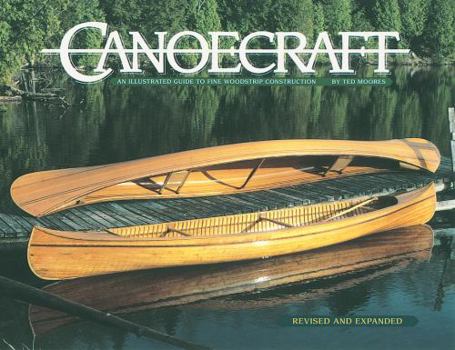Canoecraft: An Illustrated Guide to Fine Woodstrip Construction
Select Format
Select Condition 
Book Overview
Reviews of previous edition: An excellent definitive book... something you must read if you are going to build a woodstrip canoe. If you want to build a strip-plank canoe or kayak, Canoecraft is the book to buy... A very comprehensive boatbuilding book and highly recommended. A Woodworking Magazine Top 40 Book Now...
-- Canoeist
-- Water Craft
Format:Paperback
Language:English
ISBN:1552093425
ISBN13:9781552093429
Release Date:November 2007
Publisher:Firefly Books
Length:240 Pages
Weight:1.30 lbs.
Dimensions:0.8" x 10.7" x 8.0"
Customer Reviews
5 ratings
The revised edition is even better than the original!
Published by Thriftbooks.com User , 19 years ago
I am making my fourth cedarstrip, the first three (Kipawa, Mattawa, and Chestnut Prospector) following the original edition as my guide and reference manual. I ordered the new edition partly because I'd worn out the original, but even after having built three cedarstrip canoes, I found new information and ideas in the revised edition making it worthwhile. The new edition has improved and expanded information about various building tips, jigs to make the building go better, a new section on staple-less building (the style I've used for all four canoes), an expanded section on canoe repair, and a new chapter on paddle making, among other improvements. This book is a gold mine of information about building cedarstrip canoes, and comes as close to "step by step" instructions as I could imagine. It is slightly limited in scope, for example, by concentrating on only a range of products and sources available for materials, but otherwise terrific. For example, it only discusses (and borrows heavily from material about) the West System epoxies, bypassing some very valuable alternatives that a more complete discussion would include. (Examples: it omits discussion of Mas Epoxies or System Three epoxy materials, which include a very nice new product line for strippers that gives a nearly clear coating rather than the amber colored finish that West Systems and earlier System Three and Mas products give you.) It could also profitably include information on more of the modern designs available (e.g., John Winters' work). But these are quibbles; it is an outstanding book, improved significantly in the revised edition.
This is a must have
Published by Thriftbooks.com User , 20 years ago
I have read other books on canoe building and this one was for me the best. It has good advice on which style of wood strip canoe to build for your purpose, looks at plans, materials and tools and then goes through the process of building a 16 foot Redbird. It had enough detail (marginally fuzzy b & w photos but excellent line drawings) to guide me, a complete beginner, through the whole process and I recommend it. Other books have great tips and overviews of the techniques, and are useful for additional information; but this was the one that, by leading me through each step in enough detail from start to finish answering my questions as it went, made me confident that I could safely start the project and build that canoe.
The best book on strip building
Published by Thriftbooks.com User , 22 years ago
Moore's book was probably the first to deal with strip building using epoxy, and he has always been one of the best builders. Last time I was at the Canadian Canoe Museum, he was there too, working in the shop. There isn't anyone better than him, and he has written several great books. He was generous to me 20 yrs ago, before the publication of his first book, when my epoxy was going bad, and he was helpful on the other end of the phone.I have bought this the second book, and I think it is a useful revision to the first. Some of the jigs are better, and the designs are far more useful than those that appeared in the first book. I think they will appeal to most home builders, and combine several modern favorites, with traditional ones. My one small quible is that in general we still don't have designs in these books which are the equal of those coming out of the best factories, say Bell as one example. But that's the kind of thing that doesn't seem to interest most builders.Others say the mold tables are difficult to read. They are merely traditional. Read them as feet, inches, eigths, and plus or minus 1/16. That's boatbuilding. Most builders will never try to loft these in several views, strips make a casual approach possible, since they are largely self-fairing. That being the case talk of difficult lofting is highly exagerated.Highly recomended
Been There - Done That
Published by Thriftbooks.com User , 22 years ago
I've used Ted Moores' book to build a Redbird design and could not be happier with my canoe. The author was very precise in expaining all the steps neccasary to complete the project. If anyone is intrested in pesonal watercraft or traditional apperance this book is a must have.
Great book
Published by Thriftbooks.com User , 23 years ago
A very good book for the beginner. While the lofting of the patterns can be intimidating, the author does a good job of explaning the basics. The plans and the information contained in the book are very helpful. One thing building a canoe with an inner stem can be a bit tricky, you may opt to just run the strips past the form and glue the together this works very well.




